This is how we’ve come to the point today, during the driest decade in state history, that valley farmers haven’t diminished their footprint to meet water’s scarcity but have added a half-million more acres of permanent crops—more almonds, pistachios, mandarins. They’ve lowered their pumps by hundreds of feet to chase the dwindling aquifer even as it dwindles further, sucking so many millions of acre-feet of water out of the earth that the land is sinking. This subsidence is collapsing the canals and ditches, reducing the flow of the very aqueduct that we built to create the flow itself.
How might a native account for such madness?
No civilization had ever built a grander system to transport water. It sprawled farmland. It sprawled suburbia. It made rise three world-class cities, and an economy that would rank as the fifth largest in the world. But it did not change the essential nature of California. Drought is California. Flood is California. One year our rivers and streams produce 30 million acre-feet of water. The next year, they produce 200 million acre-feet. The average year, 72.5 million acre-feet, is a lie we tell ourselves.
www.technologyreview.com/2021/12/16/1041296/california-climate-change-water-drought








